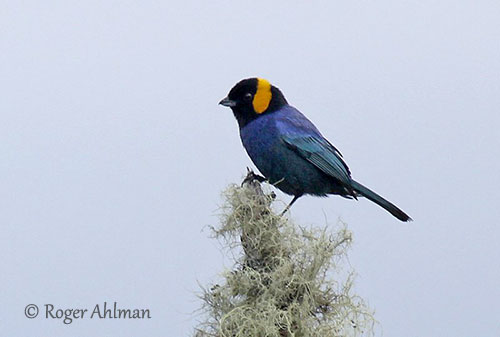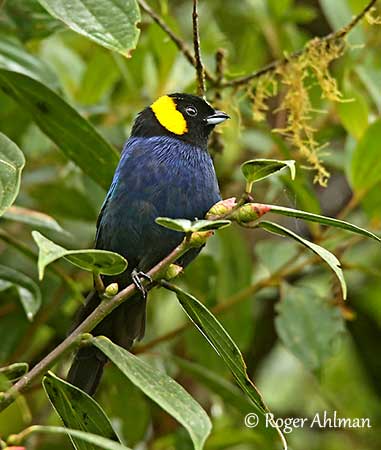
Fr: Tangara de Reinhardt
Ang: Yellow-scarfed Tanager
All: Goldbandtangare
Esp: Tangara de Reinhardt - Tangara de Bufanda Amarilla (Pérou)
Ita: Tanagra sciarpagialla
Nd: Goudbandtangare
Sd: guldbandad tangara
Photographers:
Roger Ahlman
Pbase Galleries Peru and Ecuador
Dubi Shapiro
Dubi Shapiro Photo Galleries
Text by Nicole Bouglouan
Sources:
HANDBOOK OF THE BIRDS OF THE WORLD Vol 16 by Josep del Hoyo- Andrew Elliot-David Christie – Lynx Edicions – ISBN: 9788496553781
TANAGERS: Natural History, Distribution and Identification (Helm Identification Guides) - By Morton L. Isler and Phyllis R. Isler - Christopher Helm Publishers Ltd; New edition (30 April 1999) - ISBN-10: 0713651164
BIRDS OF PERU by Thomas S. Schulenberg, Douglas F. Stotz, Daniel F. Lane, John P. O’Neill, Theodore A. Parker III – Princeton University Press 2007– ISBN: 978-0-691-13023-1
BIRDS OF SOUTH AMERICA – Passerines - by Robert S. Ridgely and Guy Tudor – HELM Field Guides – ISBN: 9781408113424
Neotropical Birds – Cornell Lab of Ornithology
Arthur Grosset's Birds (Arthur Grosset)
Thraupidae – Tanagers & Allies
Yellow-scarfed Tanager
Iridosornis reinhardti
Passeriformes Order – Thraupidae Family
INTRODUCTION:
The Yellow-scarfed Tanager is endemic to Peru where it occurs on the E slope of the Andes. It frequents trees and shrubs in both montane and elfin forests, between 2,000 and 3,700 metres of elevation.
It feeds primarily on small fruits and berries, and occasionally takes some insects. It forages from just above the ground to the canopy of small trees. The breeding behaviour of the species is unknown.
Although being a restricted-range species, the Yellow-scarfed Tanager is not globally threatened. It is affected locally by degradation and destruction of forest, but it is present in several protected areas.
The name of this species pays tribute to the Danish zoologist Johannes Theodor Reinhardt (1816-1882) who was also the Director of the Natural History Museum of Copenhagen.

DESCRIPTION OF THE BIRD:
Biometrics:
Length: 14 cm
Weight: 20-28 g
The Yellow-scarfed Tanager has purplish-blue body plumage with sometimes some chestnut on the undertail-coverts. On the upperwing, coverts, flight-feathers and tertials are black, with broad greenish-blue edges. The tail is dark blue.
Head, neck, throat and mantle are black, contrasting strongly with a broad, golden-yellow band across the head, from ear to ear up over the hind crown.
The stout, conical, two-tone bill has blackish upper mandible whereas the lower mandible is pale grey with dark tip. The eyes are dark reddish-brown. Legs and feet are blackish.
Male and female are similar.
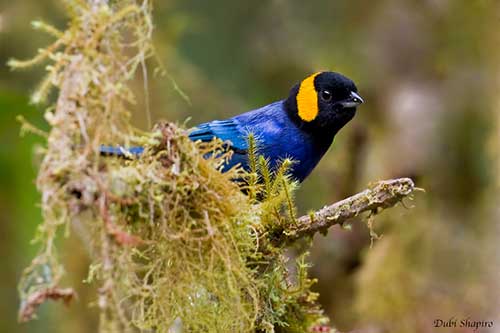
The juvenile is darker. Wing and tail are similar to adult. There is sometimes some reddish-brown mottling on the undertail-coverts.
RANGE:
The Yellow-scarfed Tanager is found on the eastern Andean slope in Peru, S of Marañón Valley (from Amazonas to Ayacucho) and Cordillera Vilcabamba in Cuzco.
HABITAT:
The Yellow-scarfed Tanager is found in humid montane forest and in elfin forest in trees and shrubs, also at forest edge and on scrubby hillsides near forest, from 2,000 up to 3,700 metres of elevation.
CALLS AND SONGS: SOUNDS BY XENO-CANTO
The Yellow-scarfed Tanager gives high-pitched calls “tzi-zi”, “tip” or “ti”.
The song is a clear, high-pitched “tsee-tsee-dee”.
BEHAVIOUR IN THE WILD:
The Yellow-scarfed Tanager feeds mainly on small fruits and berries, and may sometimes catch some insects.
It usually forages from the ground to the tops of small trees, by hopping along the branches covered with moss, and by leaning tree trunks while probing and picking at moss. It may sometimes hang down to reach small leaves and glean prey from them. It also descends to the ground and probes moss-covered rocks and exposed roots.
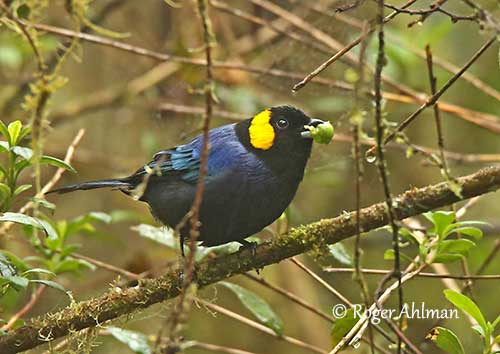
It is often very active, moving quickly through trees and shrubs, jumping up from branch to branch sometimes over almost a metre. While foraging, it may appear to tumble down branches to lower limbs below.
It forages in pairs and small groups, and often joins mixed-species foraging flocks with Plushcap and others. It rarely remains in the open for long time.
The breeding behaviour is poorly known. They are suspected to be monogamous and they defend a territory.
We can suggest that the bright golden-yellow head pattern is exposed during the displays involving bowing and tail lifting.
The Yellow-scarfed Tanager is probably resident.
While foraging, it moves through interiors of trees, quickly and actively, with fluttery, heavy flight.
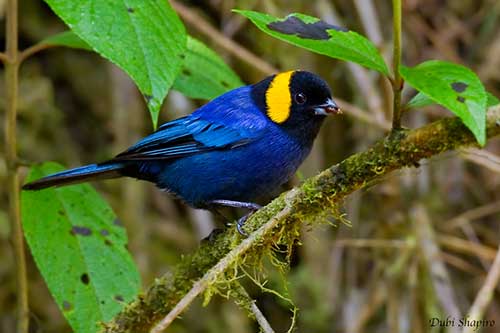
REPRODUCTION OF THIS SPECIES:
The breeding behaviour of the Yellow-scarfed Tanager is unknown.
Most tanager species build cup-shaped nests in trees. Some of them may build an almost globular structure with side entrance. The nest-site is usually hidden among dense vegetation.
The brood may contain 3 to 5 eggs and the chicks are fed by both parents.
A juvenile of the present species was seen in June in Huánuco with an adult.
But more information is needed about this species.
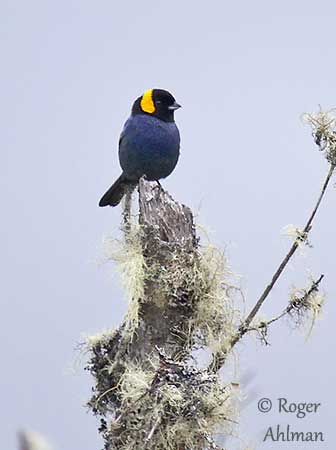
PROTECTION / THREATS / STATUS:
The Yellow-scarfed Tanager is described as fairly common within the forest at high elevation.
It may be affected locally by degradation and destruction of the forest habitat, but it is present in several protected areas.
The size of the population is unknown, but it is suspected to be stable.
The Yellow-scarfed Tanager is not globally threatened and currently evaluated as Least Concern.
